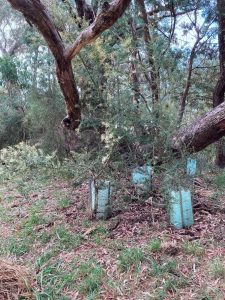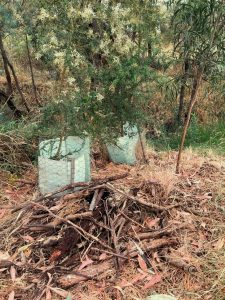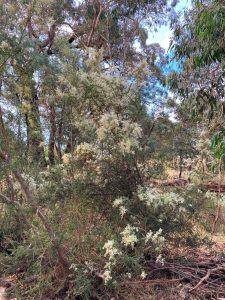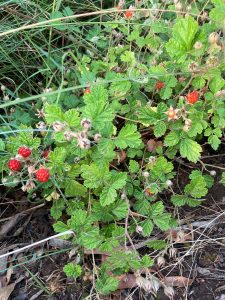
The fragrant flowers of Australian Blackthorn, Bursaria spinosa subsp. lasiophylla are rich in nectar and attract many insects.
Friends of Mt Majura will be hosting a work party on Sunday, 19 February at the drainage line close to the Hackett water tank. Please give a hand to dismantle guards that are outgrown by planted native shrubs, remove introduced grasses that smoother the plantings and mulch the plantings to suppress new weed growth.
We already cut and treated highly invasive Chilean Needle Grass and other weeds along the edge at the bottom parts of the drainage line and direct seeded native grasses and other local ground-cover plants.
When: Sunday 19 February 2023, 9 am to 12 noon; give as much time as you can spare.
Where: Meet at the drainage line close to the water reservoir off Rivett Street and French Street intersection, Hackett; view this map.
What: removing guards; hand-weed invasive grasses around planted native Blackthorn along the drainage edge and remove seedlings of English Ivy and Privet in the drainage ditch; placing woodchip mulch around the shrub plantings in a “doughnut” pattern.
Bring and wear: Sun protection, long sleeves and pants, sturdy shoes or gum boots and gloves if you have them.
Inquiries: secretary@majura.org
You need no experience to attend this event. Instructions, tools, some gloves, hand sanitiser and a delicious home-baked cake will be provided.
Please click on this link for further information on the Friends of Mt Majura drainage line project.
The following photographs show Blackthorns that have been planted in May 2018 along the drainage line. Various degrees of happiness is the result of how much care was given to the individual plants.
 The struggling blackthorn (photo left) competes with highly invasive and aggressive Chilean Needle Grass (CNG), Nasella neesina, Panic Veldtgrass, Erharta erecta and Phalaris, Phalaris aquatica and hardly made it out off its guard.
The struggling blackthorn (photo left) competes with highly invasive and aggressive Chilean Needle Grass (CNG), Nasella neesina, Panic Veldtgrass, Erharta erecta and Phalaris, Phalaris aquatica and hardly made it out off its guard.
CNG is a Weed of National Significance, highly invasive and able to transform ecosystems. Rehabilitation of densely infested areas is difficult and requires a combination of various management measures such as monitoring, physical removal, herbicide application, thick mulching, cutting, and bagging seed heads and follow-up monitoring and control.
 That’s better (photo right): the introduced grass has been cut and pulled or hacked out close to this group of three Blackthorns; foliage of regrowing Phalaris is visible in the surrounds.
That’s better (photo right): the introduced grass has been cut and pulled or hacked out close to this group of three Blackthorns; foliage of regrowing Phalaris is visible in the surrounds.
 The densely growing CNG around these two Blackthorns (photo left) has been carefully cut and sprayed and the seeds have been bagged and removed from the site.
The densely growing CNG around these two Blackthorns (photo left) has been carefully cut and sprayed and the seeds have been bagged and removed from the site.
To reduce the regrowth of CNG from a persistent and large seed bank, the Friends of Mt Majura propose thick mulching with wood chips and direct seeding of native grasses and other ground cover plants.
See grass species on Canberra Nature Map: Chilean Needle Grass, Phalaris and Panic Veldtgrass
A native raspberry fruiting for the first time since it was planted along the bottom part of the drainage to replace Blackberry, a Weed of National Significance and other weeds such as English Ivy and Japanese Honeysuckle. Native raspberries grow naturally further uphill in the drainage line; the plantings were raised from softwood cuttings.
Photographs on this page by W. Pix.




